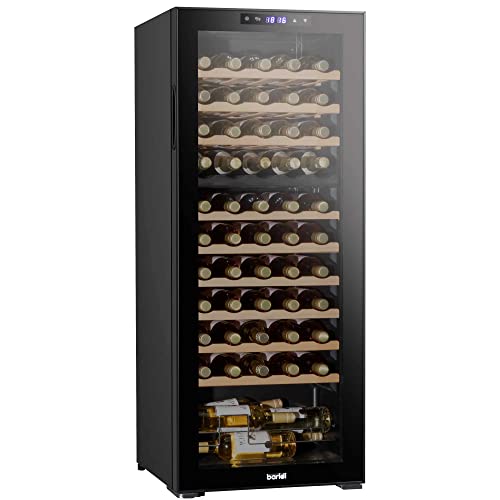Ten Things You Should Never Share On Twitter
페이지 정보

본문
 The Benefits of a Wine Fridge Cooler
The Benefits of a Wine Fridge CoolerA wine refrigerator cooler keeps bottles at the ideal temperature for aging. A well-designed wine refrigerator regulates humidity levels to prevent corks drying out and burning.
 Choose a wine refrigerator with several temperature zones. This is a great feature when you have different kinds of wine with different needs for storage.
Choose a wine refrigerator with several temperature zones. This is a great feature when you have different kinds of wine with different needs for storage.Compressor-based cooling
Wine fridge coolers use compressor technology to keep your favorite wines at an optimal temperature for serving or long-term storing. This kind of cooling system is frequently found in beverage refrigerators. It gives an even temperature throughout the refrigerator.
Freestanding or built-in wine fridges that use this cooling technology can be added to your kitchen, bar or wine cellar closet. They can be mounted under counter or concealed, and in a lot of cases, have front-facing ventilation in the cabinet to blend seamlessly into other kitchen appliances.
Wine refrigerators that use this cooling technology not only maintain the correct temperature but also perform other functions essential for storing wines. They can, for example come with a humidification control system which checks the air inside the refrigerator and adjusts water flow in order to ensure that the wine bottles are properly moistified. This prevents oxidation which can alter the flavor of the wine.
Certain wine coolers feature dual or even triple temperature zones, meaning you can store various types of wine at the right temperature. This is an excellent option for those who prefer serving both red and white wines or wish to separate their wine collection into various storage categories.
Some wine refrigerators use this type of cooling to create the wine with a UV-resistant glass door that protects the wine from harmful UV radiation.
In addition to their ability to cool wine at the right temperature, wine refrigerators with this technology are generally quiet and produce no vibrations. They do not utilize liquid refrigeration and therefore do have moving parts that oscillate or cycle when they are running. This reduces vibrations that can lead to loose connections to the hardware and other issues with the internal components of the wine refrigerator cooler. It also helps to minimize the noise generated by the cooling system and keep your wine tasting its best wine refrigerator.
Thermoelectric cooling
Thermoelectric coolers are a different technology than compressor-based units. Instead of refrigerants, thermoelectric coolers rely on the Peltier effect to keep wine bottles cool. The Peltier effect occurs when an electric current is passed through two pieces of metal that are connected together, causing one side to warm while the other cools down. This difference in temperature is what allows the cooler to keep a cool environment inside of the cabinet.
In the majority of cases, a cooler will employ a heat sink to distribute cold air throughout the interior of the cabinet. It is typically an aluminum piece that has been electrolyzed to increase its surface area and assist in the dissipation of heat. Fans are located on either side of the heat sink in order to circulate the air and ensure a constant temperature.
This technology is eco-friendly. Thermoelectric wine refrigerators don't require refrigerants, and are therefore less harmful to the environment than coolers that use compressors. They are also less expensive to run and consume less energy than compressor-based coolers.
It is crucial to keep in mind that compressor units are more effective in keeping wine bottles at an optimal temperature than thermoelectric wine coolers. They aren't able to attain the required temperature. They also require more maintenance since they are always running.
In addition to their energy-efficient and eco-friendly capabilities thermoelectric wine refrigerators are also quiet. This makes them a fantastic option for those who live in restaurants or homes where it is important to preserve the atmosphere of the space. They are also great for living spaces where people want to entertain guests or have an alcoholic drink on their own. This is because they can be placed in any room in the house or restaurant without creating disturbance. They don't use any compressors or motors that can be noisy.
Humidity Control
Wine is sensitive to its surroundings and needs precise conditions to age properly. Temperature and humidity are crucial in this process to preserve cork integrity and quality over time. A wine fridge maintains an ideal temperature range and controls humidity to ensure a perfect aging process.
The ideal humidity level for wine storage is between 50 and 70 percent. If humidity levels decrease, the wine can lose its flavor and cause the oxidation. The excessive humidity can also be a breeding ground for mildew and mold, which could damage labels and reduce the quality of the cork. Wine refrigerators create a climate that discourages the growth of mildew and mold, protecting the appearance and taste of good wine fridge.
Many wine refrigerators have humidity control systems that regulate and maintain the proper humidity levels. These systems are equipped with an inbuilt hygrometer which monitors the air temperature in the wine fridge narrow (great post to read) cellar and then automatically adjusts the humidity settings to maintain it within the desired range.
Additionally, some wine refrigerators are equipped with internal fans that aid in the circulation of air and prevent pockets of humid or warm air from creating. This ensures constant temperatures throughout the wine storage area and reduces energy usage by minimizing fluctuations in temperature.
Most wine refrigerators come with doors made of double-paned or solid glass that provides insulation and protection from harmful UV rays, which can cause degradation of wine compounds and alter their flavor. Some also have vibration reduction mechanisms that reduce disturbances that can disturb sediment in older bottles and disrupt the aging process.
While passive cooling methods are effective for decreasing humidity, you might require introducing additional moisture in your wine refrigerator if it has been operating under insufficient conditions for prolonged periods of time. Air dehumidifiers and moisture absorbers made of mineral salts or crystals are a short-term solutions to suck up water vapour from the air. They should be cleaned frequently and replaced. If you are looking for a long-lasting solution, you can install an active air humidification system that combines a water atomizer module and a water tank.
Capacity for Storage
If you regularly enjoy wine and want to keep a few bottles of wine in the fridge for unexpected or spontaneous events A reliable wine fridge is invaluable. These appliances recreate the ideal conditions of natural caves and cellars so that your wines can get the Best wine fridge uk flavor over time.
Wine is a delicate blend of various components that interact to produce distinct aromas and flavors. Proper storage conditions can protect these qualities and stop premature aging, robbing the wine of its true essence. In a conventional refrigerator, fluctuations in temperature can damage these molecules and cause the flavors to fade. In a wine cooler consistent temperatures and humidity control will prevent these problems.
In addition to ensuring optimal temperatures, wine refrigerators regulate humidity levels to keep corks from drying out and leaking. If the wine bottle is kept in a humid environment, it's possible that the labels will peel off. The wine may also lose its taste. wine fridge large fridges maintain a relative humidity between 55 percent and 75%, protecting the integrity of the wine bottle and preventing the oxidation process.
These cooling systems usually feature internal fans that ensure uniform air circulation throughout the cabinet. This eliminates pockets of humid or warm air and keeps the whole collection at the same temperature. A lot of units include racks and shelves designed to be able to comfortably and securely hold bottles. This will shield your bottles from harm, and help you organize them efficiently.
Certain wine refrigerators have dual temperature zones that can be used to store different kinds of wine at their optimal temperatures. Other features that are common to these devices include UV-resistant doors and LED lighting. These features protect your wines safe from sun damage while also making them accessible. Certain wine refrigerators come with carbon filters that help to eliminate the smell of air that can get through the corks of the bottles and alter the taste of the wine.
When shopping for a wine fridge, consider the amount of space you have available and how extensive your collection is. Most wine coolers can be incorporated into cabinets or under counters, and are available in a variety of sizes and shapes. Some have front venting so you can install them in a narrower space. Some wine refrigerators have adjustable shelves, which allow you to take in bottles with odd shapes.
- 이전글Current Developments In Packaging 24.10.24
- 다음글9 . What Your Parents Teach You About Daftar Akun Togel Resmi 24.10.24
댓글목록
등록된 댓글이 없습니다.